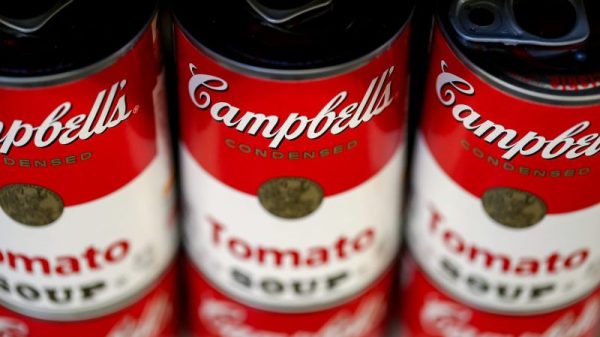Promising to make things more expensive when consumers already are angry over high prices might seem an unusual political strategy. But it’s one that both President Biden and former president Donald Trump are choosing.
Both men, as they vie for a second White House term, say that tariffs on imported Chinese goods are needed to promote domestic manufacturing and to clap back at China’s zero-sum trade practices. While economists say that tariffs result in higher prices, both Biden and Trump insist that consumers will be unscathed.
Biden’s tariffs on $18 billion in Chinese electric vehicles, batteries and computer chips, announced last month, are likely too small to lift the economy’s overall price level, economists said. But Trump’s plan for 60 percent tariffs on all $427 billion in goods that China ships to the United States each year would almost certainly reshape trade in ways that consumers would notice.
“It’s a much bigger shock for sure. Yes, it would definitely be felt,” said Mary Lovely, an economist with the Peterson Institute for International Economics who co-wrote a recent analysis of Trump’s plan.
When Trump in 2018 imposed tariffs on a wide range of Chinese imports, he promised that China would pay while critics warned that the result would be higher prices for Americans.
The actual outcome provided talking points for both sides.
GET CAUGHT UP
Summarized stories to quickly stay informed
Chief Justice Roberts declines to meet with Democrats on court ethics
Will Trump go to jail? Can he be president? What’s next after guilty verdict?
Bruhat Soma wins Scripps National Spelling Bee in second-ever spell-off
How a fed-up carpenter found his stolen power tools — and 15,000 others
Here’s how long it takes workers to become 401(k) millionaires
Contrary to expectations, the U.S. inflation rate fell after the tariffs were imposed and remained lower for almost three years, until the pandemic upended global supply chains. Consumer prices were rising at an annual 2.9 percent rate in July 2018 when the first China tariffs took effect. One year later, inflation was below 2 percent.
But that did not mean that the Chinese were paying the tab. Numerous studies concluded that the costs fell on Americans, if not on consumers. Trump’s tariffs “had little to no impact on the prices received by foreign exporters,” according to a 2018 study by economists Mary Amiti of the Federal Reserve Bank of New York, Stephen Redding of Princeton University and David Weinstein of Columbia University.
The Americans who paid the tariffs were people like Lance Ruttenberg, chief executive of American Textile Company, whose headquarters in Duquesne, Pa., stands where Andrew Carnegie once reigned over a steelmaking empire.
Ruttenberg’s 99-year-old company is one of nearly 225,000 U.S. importers that purchase items from foreign suppliers and then either use them to make finished goods or sell them to consumers.
As basic textile and fabric production moved offshore in recent decades, American Textile began importing around 3,500 shipping containers full of pillow shells and specialty fabrics each year. The company saw its costs rise by millions of dollars each year for the imported Chinese materials it uses in pillows and bedding that are sold by brands such as Sealy and Tempur-Pedic.
Trump’s tariffs came at the end of a decade of ultralow inflation, which made it hard for companies to raise retail prices. Under pressure from retailers like Walmart to hold the line, importers absorbed the cost of the tariffs by shrinking their profit margins.
“The retailers, our customers, had no appetite for accepting that price increase. And so what happens is the American manufacturer winds up absorbing it,” Ruttenberg said.
A 2021 study by four economists concluded that U.S. companies absorbed “much of the higher costs associated with the tariffs by earning lower margins on their sales.”
The analysis of price data on 90,000 products found that major retailers escaped the full brunt of the tariffs by placing unusually large import orders between the announcement of the tariffs and their effective date, and by switching to suppliers outside China.
The study was conducted by Alberto Cavallo of Harvard Business School, Gita Gopinath of the International Monetary Fund, Brent Neiman at the University of Chicago and Jenny Tang with the Federal Reserve Bank of Boston.
There were other reasons for the muted consumer price reaction. The dollar rose about 10 percent against the yuan in 2018, which offset a portion of the tariffs’ impact by making Chinese products less expensive.
Other Asian currencies fell alongside the yuan. So prices for goods from suppliers in South Korea, Vietnam and Indonesia, also declined. That allowed some U.S. buyers to switch from tariffed Chinese products to less expensive alternatives.
Plus, the anti-China tariffs were rolled out in several waves, meaning the full effects were not felt for more than a year after the trade war began. The first two waves of 25-percent tariffs hit a relatively small volume of goods, just $50 billion. To minimize the political fallout, Trump’s trade team refrained from hitting everyday products used in American homes, concentrating instead on industrial goods.
The third and largest tariff list, covering $200 billion in Chinese imports, imposed 10 percent tariffs in September 2018. A final 15 percent tariff on $112 billion in imports was announced in September 2019, bringing the total value of affected products to roughly $360 billion.
A few months later, the pandemic plunged the economy into a deep freeze, overwhelming the tariffs’ effects. Inflation virtually disappeared by May 2020. But then, as global supply chains struggled to keep pace with consumer demand for products to make the work-from-home era more agreeable, prices soared, igniting an inflationary episode that has yet to end.
In a recent interview with Time magazine, Trump repeated his false claim that other countries pay U.S. tariffs and rejected the idea that Americans would suffer.
“I don’t believe it’ll be inflation,” Trump said, adding that his tariffs are intended to convince foreign companies to build new factories in the United States.
But the renewed China trade war that Trump promises is unlikely to be as painless for consumers as the 2018-2019 campaign, economists said. His new tariffs would cost the typical middle-class household an extra $1,700 annually, according to the Peterson Institute study co-written by Lovely and economist Kim Clausing.
First, the sheer magnitude of the import taxes will be larger. Trump has proposed a 60 percent tariff on Chinese goods, roughly four times the average levy of his original policy, and a 10 percent tax on the $3 trillion in merchandise that the United States imports each year from all countries.
Some companies are already making contingency plans. Stanley Black & Decker chief executive Donald Allan told analysts last month that he still has “PTSD” from the $300 million in annual tariff costs the toolmaker incurred during Trump’s original trade war. The company has cut its import reliance on Chinese suppliers from 40 percent to no more than 25 percent and would diversify further if tariffs increase, he said.
Stanley Black & Decker also would probably “have to do some surgical price actions,” as well, Allan said.
Finally, circumstances have changed since 2018. Importers cannot count on the dollar rising as much as it did then. And after three years of elevated inflation, companies may be able to more quickly pass along their higher costs to consumers.
“My gut is that the impacts will be much more visible,” said economist Brad Setser of the Council on Foreign Relations.
American Textile responded to the 2018 tariffs by shifting about 30 percent of its supply chain from China to other countries, such as Vietnam, India and Pakistan. And it eventually secured government permission to continue importing on a tariff-free basis some items that could not be obtained from American suppliers.
Yet the existing tariffs, which Biden left in place after criticizing them during the 2020 campaign, are still being felt. As the Federal Reserve struggles to bring rising prices under control, the China tariffs are keeping the annual inflation rate about 0.3 percentage points higher than it otherwise would be, according to a 2022 Peterson study by economist Katheryn Russ.
Some new American Textile products that contain tariffed inputs are more expensive than they otherwise would have been, Ruttenberg said.
“As you develop products going forward using these new input costs, inevitably the price of the next generation of a product is higher than it would have been absent the tariffs being there,” he said. “So inevitably the prices of everything increase over time.”
Promising to make things more expensive when consumers already are angry over high prices might seem an unusual political strategy. But it’s one that both President Biden and former president Donald Trump are choosing.
Both men, as they vie for a second White House term, say that tariffs on imported Chinese goods are needed to promote domestic manufacturing and to clap back at China’s zero-sum trade practices. While economists say that tariffs result in higher prices, both Biden and Trump insist that consumers will be unscathed.
Biden’s tariffs on $18 billion in Chinese electric vehicles, batteries and computer chips, announced last month, are likely too small to lift the economy’s overall price level, economists said. But Trump’s plan for 60 percent tariffs on all $427 billion in goods that China ships to the United States each year would almost certainly reshape trade in ways that consumers would notice.
“It’s a much bigger shock for sure. Yes, it would definitely be felt,” said Mary Lovely, an economist with the Peterson Institute for International Economics who co-wrote a recent analysis of Trump’s plan.
When Trump in 2018 imposed tariffs on a wide range of Chinese imports, he promised that China would pay while critics warned that the result would be higher prices for Americans.
The actual outcome provided talking points for both sides.
GET CAUGHT UP
Summarized stories to quickly stay informed
Chief Justice Roberts declines to meet with Democrats on court ethics
Will Trump go to jail? Can he be president? What’s next after guilty verdict?
Bruhat Soma wins Scripps National Spelling Bee in second-ever spell-off
How a fed-up carpenter found his stolen power tools — and 15,000 others
Here’s how long it takes workers to become 401(k) millionaires
Contrary to expectations, the U.S. inflation rate fell after the tariffs were imposed and remained lower for almost three years, until the pandemic upended global supply chains. Consumer prices were rising at an annual 2.9 percent rate in July 2018 when the first China tariffs took effect. One year later, inflation was below 2 percent.
But that did not mean that the Chinese were paying the tab. Numerous studies concluded that the costs fell on Americans, if not on consumers. Trump’s tariffs “had little to no impact on the prices received by foreign exporters,” according to a 2018 study by economists Mary Amiti of the Federal Reserve Bank of New York, Stephen Redding of Princeton University and David Weinstein of Columbia University.
The Americans who paid the tariffs were people like Lance Ruttenberg, chief executive of American Textile Company, whose headquarters in Duquesne, Pa., stands where Andrew Carnegie once reigned over a steelmaking empire.
Ruttenberg’s 99-year-old company is one of nearly 225,000 U.S. importers that purchase items from foreign suppliers and then either use them to make finished goods or sell them to consumers.
As basic textile and fabric production moved offshore in recent decades, American Textile began importing around 3,500 shipping containers full of pillow shells and specialty fabrics each year. The company saw its costs rise by millions of dollars each year for the imported Chinese materials it uses in pillows and bedding that are sold by brands such as Sealy and Tempur-Pedic.
Trump’s tariffs came at the end of a decade of ultralow inflation, which made it hard for companies to raise retail prices. Under pressure from retailers like Walmart to hold the line, importers absorbed the cost of the tariffs by shrinking their profit margins.
“The retailers, our customers, had no appetite for accepting that price increase. And so what happens is the American manufacturer winds up absorbing it,” Ruttenberg said.
A 2021 study by four economists concluded that U.S. companies absorbed “much of the higher costs associated with the tariffs by earning lower margins on their sales.”
The analysis of price data on 90,000 products found that major retailers escaped the full brunt of the tariffs by placing unusually large import orders between the announcement of the tariffs and their effective date, and by switching to suppliers outside China.
The study was conducted by Alberto Cavallo of Harvard Business School, Gita Gopinath of the International Monetary Fund, Brent Neiman at the University of Chicago and Jenny Tang with the Federal Reserve Bank of Boston.
There were other reasons for the muted consumer price reaction. The dollar rose about 10 percent against the yuan in 2018, which offset a portion of the tariffs’ impact by making Chinese products less expensive.
Other Asian currencies fell alongside the yuan. So prices for goods from suppliers in South Korea, Vietnam and Indonesia, also declined. That allowed some U.S. buyers to switch from tariffed Chinese products to less expensive alternatives.
Plus, the anti-China tariffs were rolled out in several waves, meaning the full effects were not felt for more than a year after the trade war began. The first two waves of 25-percent tariffs hit a relatively small volume of goods, just $50 billion. To minimize the political fallout, Trump’s trade team refrained from hitting everyday products used in American homes, concentrating instead on industrial goods.
The third and largest tariff list, covering $200 billion in Chinese imports, imposed 10 percent tariffs in September 2018. A final 15 percent tariff on $112 billion in imports was announced in September 2019, bringing the total value of affected products to roughly $360 billion.
A few months later, the pandemic plunged the economy into a deep freeze, overwhelming the tariffs’ effects. Inflation virtually disappeared by May 2020. But then, as global supply chains struggled to keep pace with consumer demand for products to make the work-from-home era more agreeable, prices soared, igniting an inflationary episode that has yet to end.
In a recent interview with Time magazine, Trump repeated his false claim that other countries pay U.S. tariffs and rejected the idea that Americans would suffer.
“I don’t believe it’ll be inflation,” Trump said, adding that his tariffs are intended to convince foreign companies to build new factories in the United States.
But the renewed China trade war that Trump promises is unlikely to be as painless for consumers as the 2018-2019 campaign, economists said. His new tariffs would cost the typical middle-class household an extra $1,700 annually, according to the Peterson Institute study co-written by Lovely and economist Kim Clausing.
First, the sheer magnitude of the import taxes will be larger. Trump has proposed a 60 percent tariff on Chinese goods, roughly four times the average levy of his original policy, and a 10 percent tax on the $3 trillion in merchandise that the United States imports each year from all countries.
Some companies are already making contingency plans. Stanley Black & Decker chief executive Donald Allan told analysts last month that he still has “PTSD” from the $300 million in annual tariff costs the toolmaker incurred during Trump’s original trade war. The company has cut its import reliance on Chinese suppliers from 40 percent to no more than 25 percent and would diversify further if tariffs increase, he said.
Stanley Black & Decker also would probably “have to do some surgical price actions,” as well, Allan said.
Finally, circumstances have changed since 2018. Importers cannot count on the dollar rising as much as it did then. And after three years of elevated inflation, companies may be able to more quickly pass along their higher costs to consumers.
“My gut is that the impacts will be much more visible,” said economist Brad Setser of the Council on Foreign Relations.
American Textile responded to the 2018 tariffs by shifting about 30 percent of its supply chain from China to other countries, such as Vietnam, India and Pakistan. And it eventually secured government permission to continue importing on a tariff-free basis some items that could not be obtained from American suppliers.
Yet the existing tariffs, which Biden left in place after criticizing them during the 2020 campaign, are still being felt. As the Federal Reserve struggles to bring rising prices under control, the China tariffs are keeping the annual inflation rate about 0.3 percentage points higher than it otherwise would be, according to a 2022 Peterson study by economist Katheryn Russ.
Some new American Textile products that contain tariffed inputs are more expensive than they otherwise would have been, Ruttenberg said.
“As you develop products going forward using these new input costs, inevitably the price of the next generation of a product is higher than it would have been absent the tariffs being there,” he said. “So inevitably the prices of everything increase over time.”





















